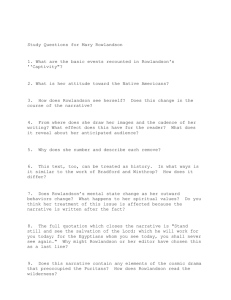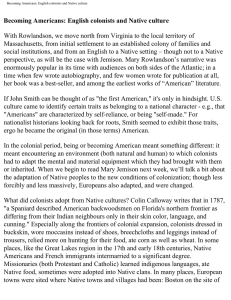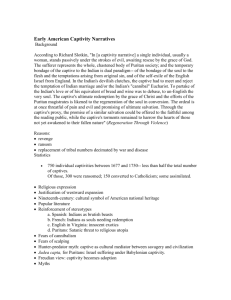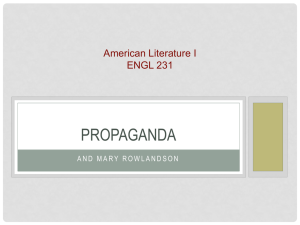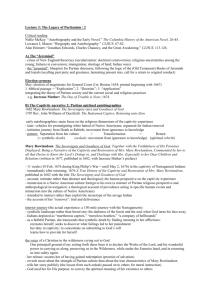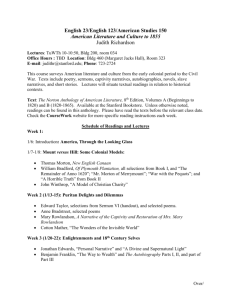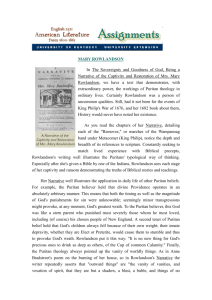RG.Rowlandson.doc
advertisement
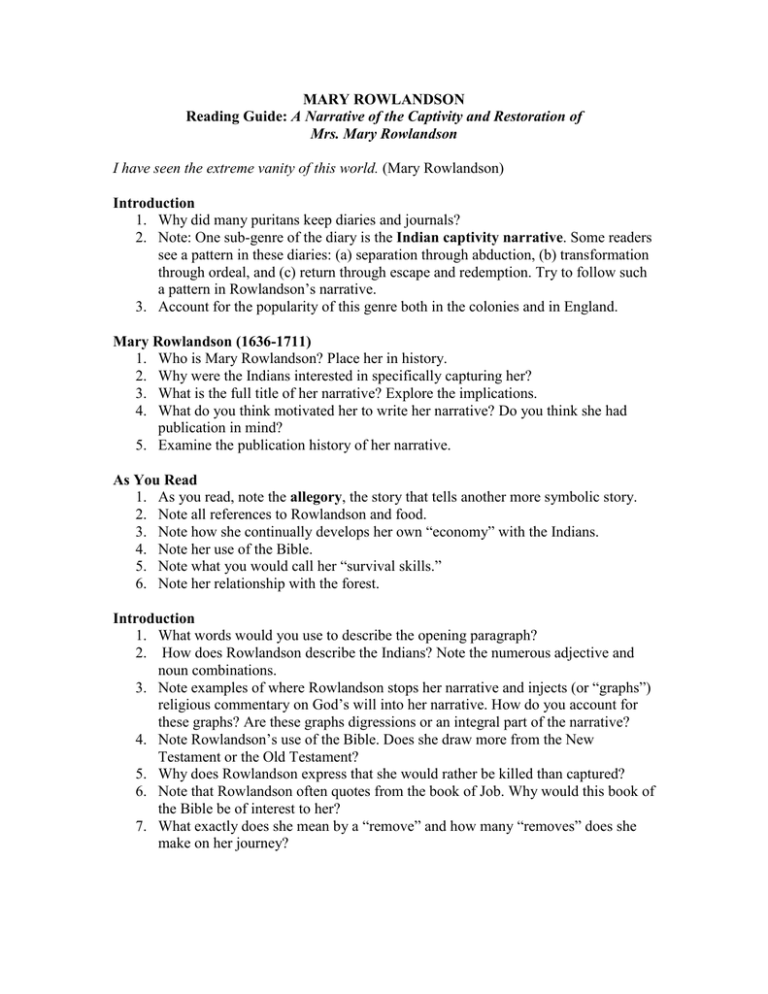
MARY ROWLANDSON Reading Guide: A Narrative of the Captivity and Restoration of Mrs. Mary Rowlandson I have seen the extreme vanity of this world. (Mary Rowlandson) Introduction 1. Why did many puritans keep diaries and journals? 2. Note: One sub-genre of the diary is the Indian captivity narrative. Some readers see a pattern in these diaries: (a) separation through abduction, (b) transformation through ordeal, and (c) return through escape and redemption. Try to follow such a pattern in Rowlandson’s narrative. 3. Account for the popularity of this genre both in the colonies and in England. Mary Rowlandson (1636-1711) 1. Who is Mary Rowlandson? Place her in history. 2. Why were the Indians interested in specifically capturing her? 3. What is the full title of her narrative? Explore the implications. 4. What do you think motivated her to write her narrative? Do you think she had publication in mind? 5. Examine the publication history of her narrative. As You Read 1. As you read, note the allegory, the story that tells another more symbolic story. 2. Note all references to Rowlandson and food. 3. Note how she continually develops her own “economy” with the Indians. 4. Note her use of the Bible. 5. Note what you would call her “survival skills.” 6. Note her relationship with the forest. Introduction 1. What words would you use to describe the opening paragraph? 2. How does Rowlandson describe the Indians? Note the numerous adjective and noun combinations. 3. Note examples of where Rowlandson stops her narrative and injects (or “graphs”) religious commentary on God’s will into her narrative. How do you account for these graphs? Are these graphs digressions or an integral part of the narrative? 4. Note Rowlandson’s use of the Bible. Does she draw more from the New Testament or the Old Testament? 5. Why does Rowlandson express that she would rather be killed than captured? 6. Note that Rowlandson often quotes from the book of Job. Why would this book of the Bible be of interest to her? 7. What exactly does she mean by a “remove” and how many “removes” does she make on her journey? First and Second Removes 1. Continue to note her descriptions of the Indians. 2. Give evidence that Rowlandson views herself on a transformative journey. 3. Prove that she is a “female Job.” 4. How does Rowlandson view the power of God at work in her life? Third Remove 1. Prove that Rowlandson feels that God is chastening her. 2. What happens to her daughter Sarah? Do the Indians have any remorse or compassion? 3. Does Rowlandson ever consider suicide? 4. What has happened to her other children whom the Indians kidnapped? 5. Note that Rowlandson receives a gift from an Indian. What is it? What is her immediate response to this gift? What passage does she turn to? How is this passage a turning point for her? 6. Who is Joslin? What does she want to do? What is Rowlandson’s response to Joslin’s plans? Fourth – Seventh Removes 1. What happens to her? Why? 2. What Bible passage does Rowlandson turn to after Joslin’s death? 3. Note Rowlandson’s continuing relationship with food. 4. Note her growing acceptance of the Indians’ ways, especially in the Seventh Remove. 5. How does Rowlandson comment on the English army’s inability to cross the river in pursuit of the Indians? 6. How does Rowlandson view the forest? Eighth – Thirteenth Removes 1. Note that for the first time Rowlandson does what before the Indians? Why has she not performed this action before? 2. Again note references to food. 3. What is the role of Rowlandson’s pocket? 4. Note examples of the Indians cruelty towards Rowlandson. Do you also detect any examples of kindness? 5. Does Rowlandson ever experience futility during her ordeal? 6. Note the death of her mistress’ papoose. Does Rowlandson show any compassion when the Indians suffer? (NOTE: You can skip Removes 14, 15, 16, and 17 if you wish.) Nineteenth – Twentieth Removes 1. Continue to note references to food. 2. Note that in the Eighteenth Remove, Rowlandson takes a child’s food and eats it. Evaluate her actions here. 3. What words does Rowlandson use to describe her Indian mistress? What is Rowlandson’s attitude on “praying” or christianized Indians? What are the terms of Rowlandson’s ransom? Why did Rowlandson not try to run away? Was Rowlandson ever sexually violated during her ordeal? Why does she make sure to comment twice on this topic? 8. How has her view of the world changed due to her experience in the forest. 4. 5. 6. 7. CRITICAL THINKING 1. With whom do you sympathize: Rowlandson or the Indians? 2. Apply feminist criticism to the narrative. a. What was expected of her as a woman positioned in Indian society? b. What is her reaction to the Indians’ treatment of Indian women? c. What is the reaction of Indian women towards her? 3. What do you make of the fact that some Puritan did not want to return to Puritan society after being captured and preferred to remain with an Indian tribe? 4. Connect Mary Rowlandson with Anne Bradstreet as both Puritan women and writers. 5. What is Rowlandson’s vision of God as expressed in her narrative? 6. Would you say that this narrative is a woman’s travel account plus religious digression or a religious tract plus travel digressions?
